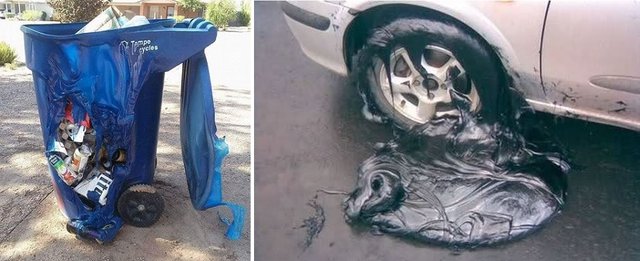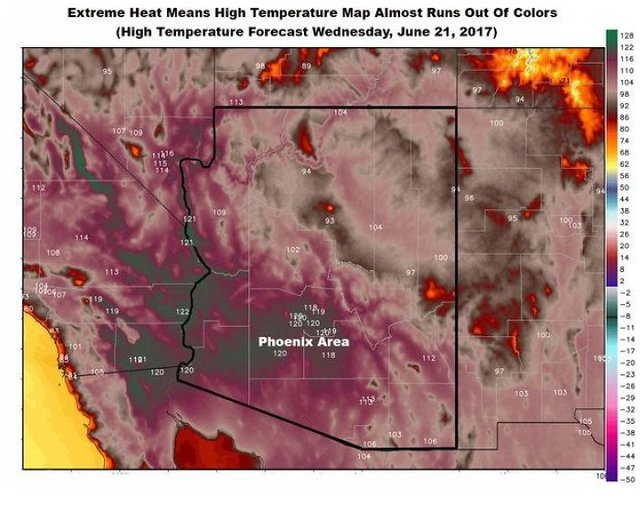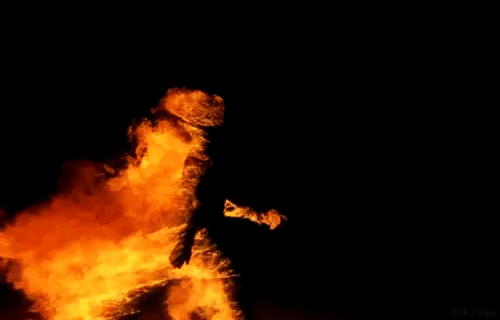
In the hottest city in the United States, Phoenix, Arizona, summer temperatures routinely exceed 42 degrees, sometimes even settling at 49 degrees.
Over the past week, the 12th largest metropolitan area in the country crossed a truly extreme heat wave, reaching 60º in some points. However, July has the warmest average temperature of the whole area, with 42º stable compared to the 40 of June. However, three of the four hottest days in Phoenix, including the 50-degree record, occurred in June.
Before people in other parts of the world get kicked and say that in their countries is the same heat, you have to leave some things clear. Obviously, there are Mexican municipalities in which the temperatures are around 50º, but most are nestled in the desert and are not the size of Phoenix. Neither do we count the thermal sensation of some of those places, in which they can reach 62 degrees.
Also in certain points of Spain, for example, every year it reaches 46º in some cities. Phoenix may not be the hottest big city in the world for many people, but experts have considered it as such for a number of reasons.


*Location
Arizona is relatively close to the equator, and as a result, receives a lot of energy from the sun, particularly at this time of year. In addition, the summer solstice offers the longest day of the year in the northern hemisphere, when the sun is at its highest point in the sky. That's why the days are longer during the summer months because of the tilt of the earth on its axis as it revolves around the sun. Those longer days offer more opportunities for things to reach higher temperatures.
*Elevation
The Phoenix area is about 300 meters above sea level. Other parts of the state have the same desert landscape as Phoenix, and many of those locations are further south and closer to the equator. Along Interstate 8, we find some of them: Yuma, Tacna, Dateland and Gila Bend, which also experience the same hot oven as Phoenix. However, many of these places have a higher elevation and, therefore, are cooler. Tucson, which is 700 meters above sea level, is 3.6 degrees colder than Phoenix in June.
*High pressure
That big H that is sometimes seen on American weather maps represents high air pressure, which is often behind the big heat waves of Phoenix in the month of June. A fairly persistent high pressure area is generally found in the southwest, a major factor in sunny weather. Because high pressure often results in clear and dry conditions, it contributes to the extreme heat of the city. In simple terms, the long, sunny days of this time of year mean more time in the sun and less time for night cooling.
*Dry heat
It appears June is the driest month of the year in Phoenix, with only 0.5 mm of rainfall on average. That's why dry air contributes to extreme temperatures, often experienced at the end of the month and before the start of the monsoon season. And all that lack of moisture means that much less energy is needed so that the sun can heat the same volume of dry air compared to the air with higher humidity level. The problem is that, unlike other inner cities or located in the desert, Phoenix is subject to quite peculiar conditions that make it very, but very warm.
*Urban heat island
This term describes how concrete, asphalt and buildings in metropolitan areas cling to heat compared to less developed areas (Mexican municipalities). Such development, particularly in the last 30 or 40 years, has caused temperatures, especially at night, to increase considerably. The overnight average for Phoenix in June 2016 was 27.8 ° C, which tied the record of this statistic established in the previous year, according to the National Weather Service, that is, 4.4 degrees above Than usual.
Either way, people on the West Coast have been forced to endure a steady rise in temperature over the past few days, reaching constant 48 degrees throughout the city. In fact, it was too hot for planes to take off due to a change in air density; American Airlines canceled 38 flights specifically. On the other hand, prisoners in Tent City, a prison housing about 1,000 offenders, had to be moved abroad, sleeping in tents and weathering the stars under their daily routine.
Medical emergencies have had to seriously recommend that people do not leave their homes at certain times of the day because of the danger of sunlight. Many traffic lights and traffic signs have melted, as well as numerous plastic bins.
Pet owners have to be careful and refresh them with water often, since dogs are seriously affected by the heat, in fact they have recommended a kind of special shoes so that they do not burn their legs with asphalt. The meteorologists had not seen such an extreme heat wave, and it is something that can not be compared to any other phenomenon related to heat.
Experts have been forced to use a magenta color scale on their weather maps to explain the intensity of heat that hits Arizona. Three days ago, on June 23, it was the first time in human history that this model was used.
Some Phoenix residents posted humorous videos showing how you could fry an egg in a frying pan in the sun at 48 degrees Celsius, or how you cooked a chocolate cookie on the hood of a car. However, older people have had to use serious measures to combat this horrible heat, moisturizing at all times and using wet cloths for the face. Apparently, Arizona is believed to be an uninhabitable place within a few years due to the inexorable increase in temperatures.


PEOPLE FROM PHOENIX!! :)

What do you think, Would you like to live there?
Downvoting a post can decrease pending rewards and make it less visible. Common reasons:
Submit
LOL
Downvoting a post can decrease pending rewards and make it less visible. Common reasons:
Submit